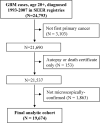Adult glioblastoma multiforme survival in the temozolomide era: a population-based analysis of Surveillance, Epidemiology, and End Results registries
- PMID: 21882183
- PMCID: PMC3235223
- DOI: 10.1002/cncr.26494
Adult glioblastoma multiforme survival in the temozolomide era: a population-based analysis of Surveillance, Epidemiology, and End Results registries
Abstract
Background: Survival after a glioblastoma multiforme (GBM) diagnosis remained static during the several decades before 1999. We hypothesized that the progressive increase in temozolomide use for GBM treatment that began in 1999 in the United States would be paralleled by a corresponding improvement in survival.
Methods: We included 19,674 GBM cases, ages 20 years or greater, diagnosed 1993 to 2007 in the population-based Surveillance, Epidemiology, and End Results Program database. We used proportional hazards models to calculate calendar period hazard ratios (HR) and 95% confidence intervals (CI), adjusted for demographic covariates. We compared survival across periods using the Kaplan-Meier method.
Results: Starting with cases diagnosed in 1999 to 2001, we observed a progressive decrease in HRs compared with cases diagnosed in 1993 to 1995. The multivariate-adjusted HR for 2005 to 2007 versus 1993 to 1995 was 0.69 (95% CI, 0.65-0.72). Age-stratified analyses revealed that this progressive decrease occurred in all age groups except 80+ years. Two-year survival increased from 7% among cases diagnosed in 1993 to 1995 and 1996 to 1998 to 9% among cases diagnosed in 1999 to 2001, 13% in 2002 to 2004, and 17% in 2005 to 2007. The disparity in survival between young and old patients increased in the temozolomide era, with 2-year survival of 39% among cases diagnosed at ages 20 to 44 years and 1% among cases diagnosed at 80+ years in 2005 to 2007.
Conclusions: We observed a modest, but meaningful, population-based survival improvement for GBM patients in the United States. Widespread adoption of temozolomide represents the most likely explanation, although other treatment advances, such as increased extent of surgical resection, also may have played a role.
Copyright © 2011 American Cancer Society.
Figures


References
-
- Central Brain Tumor Registry of the United States (CBTRUS) CBTRUS Statistical Report: Primary Brain and Central Nervous System Tumors Diagnosed in the United States in 2004–2007. CBTRUS; Hinsdale, IL: 2011. [accessed June 16, 2011]. Available from URL: http://www.cbtrus.org/2011-NPCR-SEER/WEB-0407-Report-3-3-2011.pdf.
-
- Barnholtz-Sloan JS, Sloan AE, Schwartz AG. Relative survival rates and patterns of diagnosis analyzed by time period for individuals with primary malignant brain tumor, 1973–1997. J Neurosurg. 2003;99:458–466. - PubMed
-
- Davis FG, Freels S, Grutsch J, Barlas S, Brem S. Survival rates in patients with primary malignant brain tumors stratified by patient age and tumor histological type: an analysis based on Surveillance, Epidemiology, and End Results (SEER) data, 1973–1991. J Neurosurg. 1998;88:1–10. - PubMed
-
- Deorah S, Lynch CF, Sibenaller ZA, Ryken TC. Trends in brain cancer incidence and survival in the United States: Surveillance, Epidemiology, and End Results Program, 1973 to 2001. Neurosurg Focus. 2009;20:E1. - PubMed
-
- Schering-Plough Corporation [accessed March 14, 2011];First new chemotherapy agent for brain tumors in 20 years. Available from URL: http://prnwire.com/cgibin/stories.pl?ACCT=104&STORY=/www/story/08-11-199....
Publication types
MeSH terms
Substances
Grants and funding
LinkOut - more resources
Full Text Sources
Other Literature Sources
Medical

